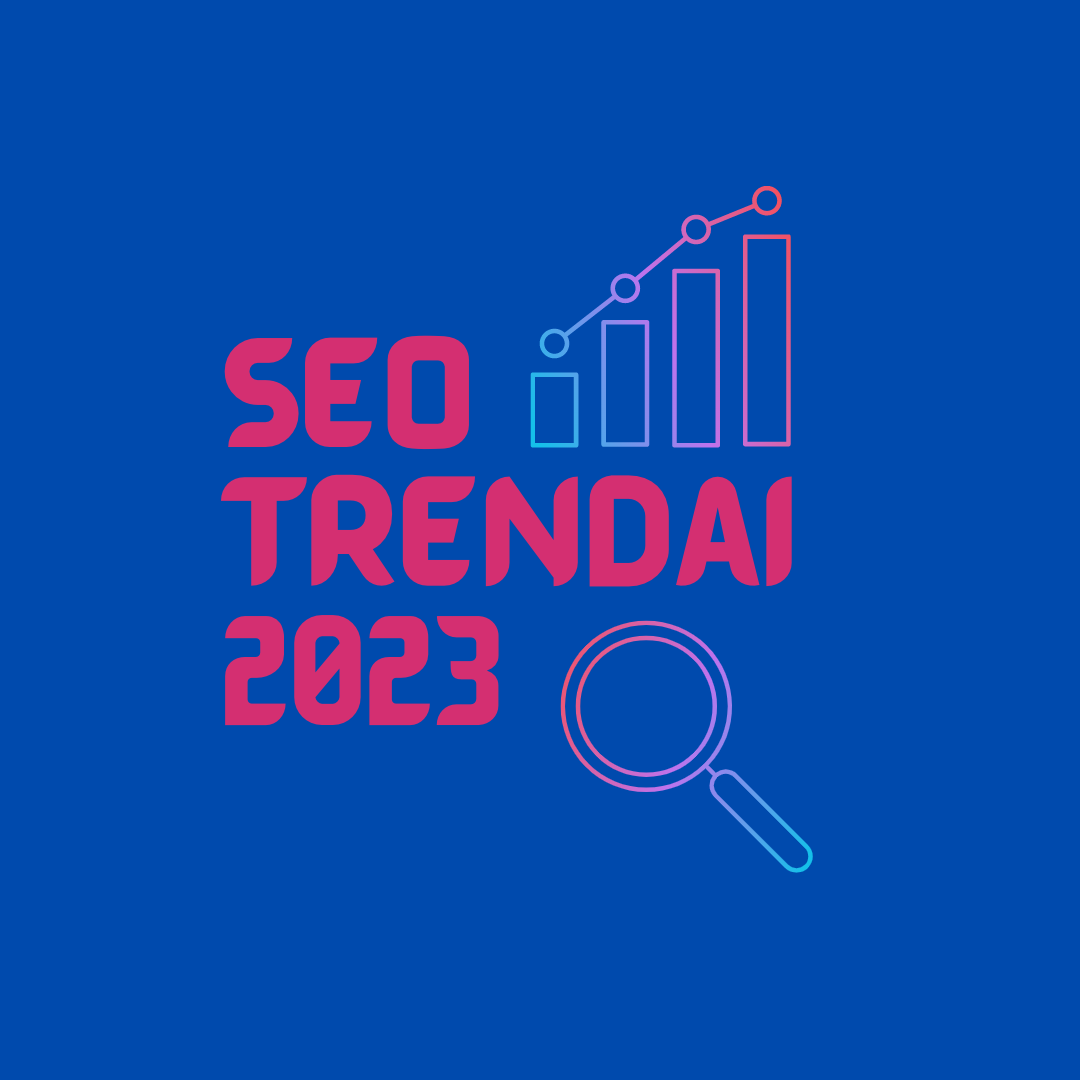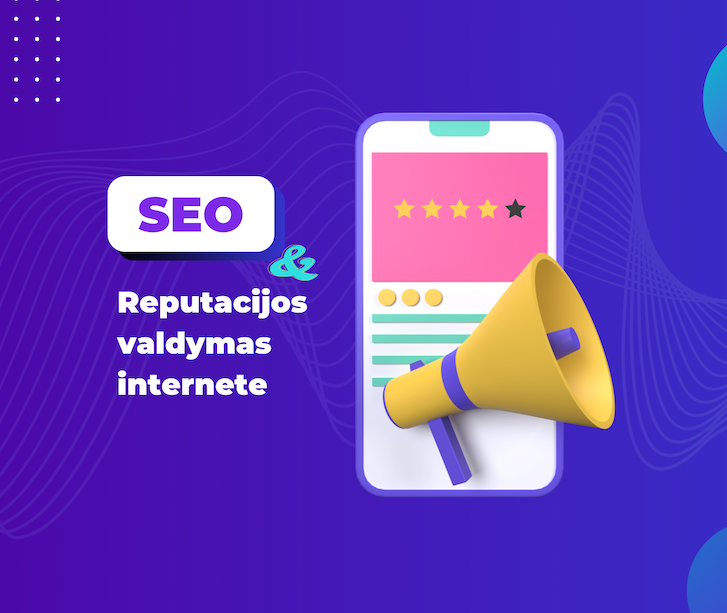It's a painful truth, but if your website doesn't rank in the top 10 positions in search engines for your keywords, chances are that your website is not visible to Google at all.
According to HubSpot, as many as 75% of searchers only choose from the first page of searches and don't even visit the second page of results, which is why it's so important to rank as high as possible in the search engines.
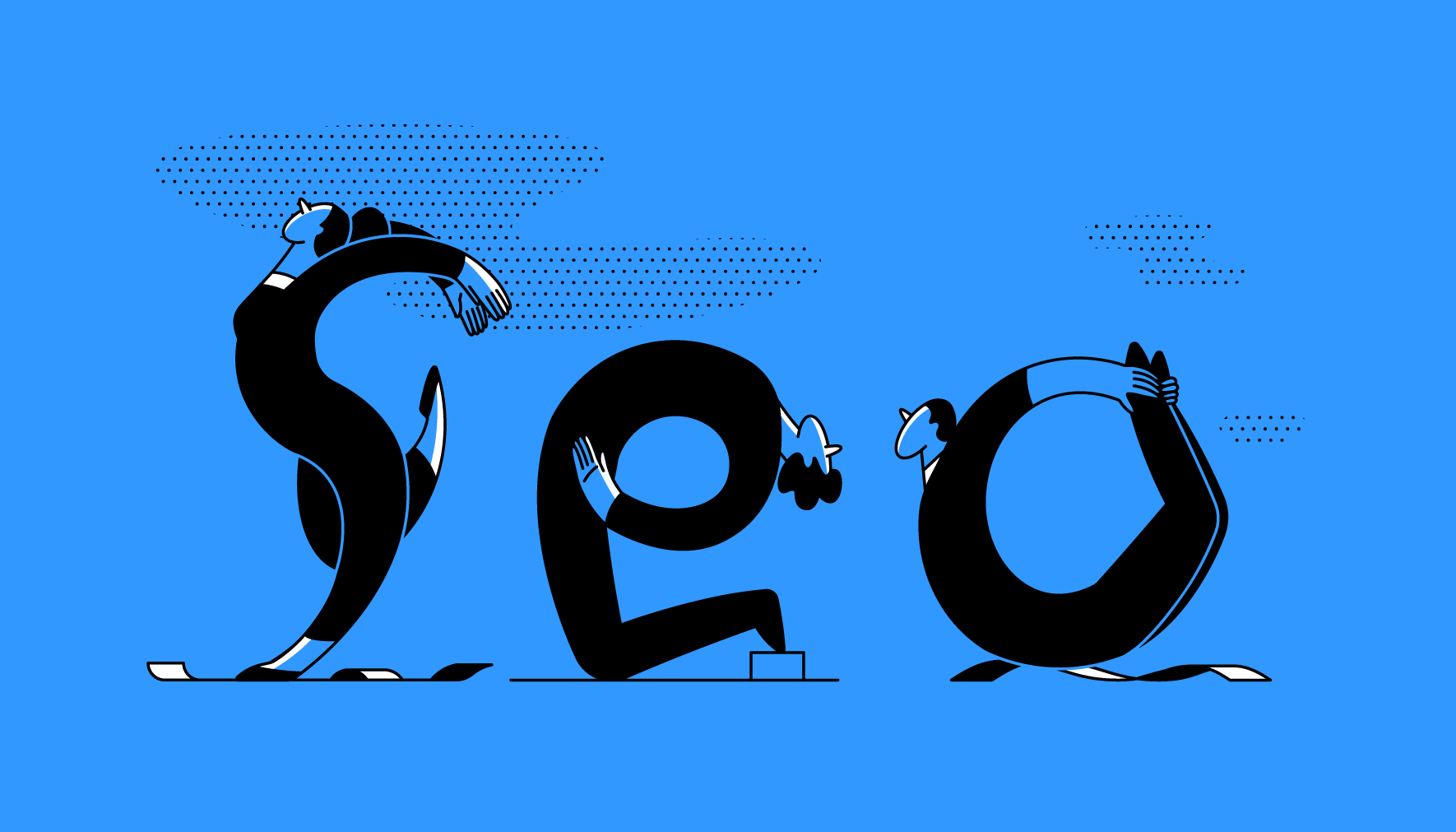
There are a number of methods and strategies that can help you move up the ranks. Without applying them correctly, the chances of ranking on the first page of Google are very minimal.
By following the best SEO strategies and practices, you can build a solid foundation for your website to move up the ranks. Once you have a strong base, you can move on to more advanced keyword research and link building strategies.
This article will outline 9 SEO best practices that, when applied and used correctly, can help you rise in the search engine rankings.
- Align your content with search intent
- Write a quality meta title tag and meta description
- Optimize your images
- Optimize your website speed
- Use internal linking
- Improve the user experience on your website
- Include keywords in your URL
- Pay attention to high authority backlinks
- Host high-volume content
1. Align your content with the search intent
Search intent (also known as user intent) is the main goal a user has when making a query in a search engine. Getting it right and satisfying the search intent is one of Google's top priorities. All pages that appear on the first page of a search engine have perfectly aligned their content with the search intent.
For example, look at the search results for "how to make oatmeal cookies".
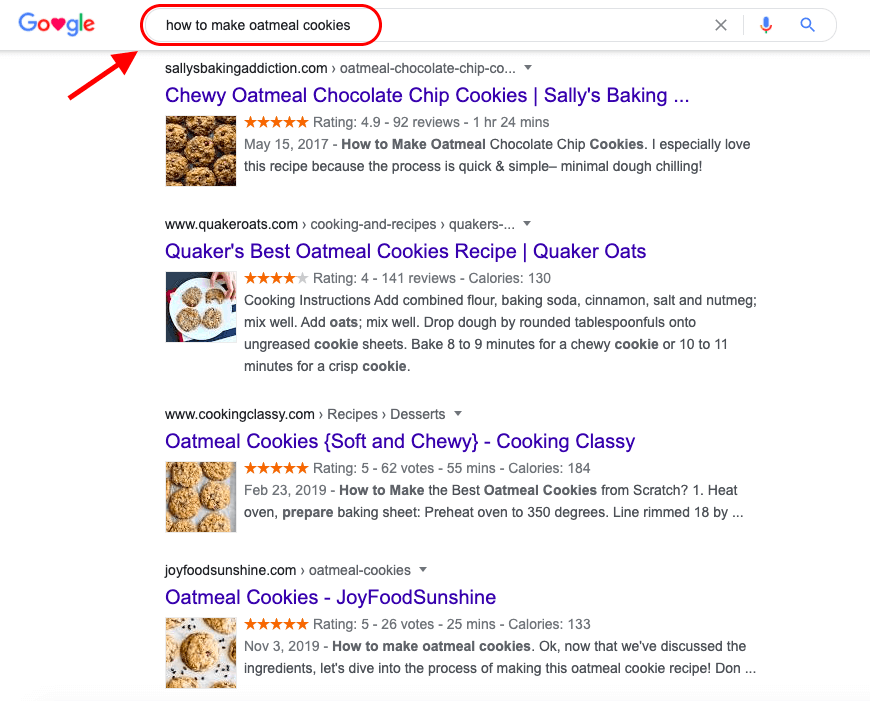
The most popular search results are blog posts or videos, not e-commerce pages selling oatmeal cookies. Google understands that people making this specific search want to make their own rather than buy.
On the other hand, the most popular search results for the query "buy oatmeal cookies" are e-commerce sites. In this case, because Google understands that people are interested in buying, it provides links to where to buy a particular product. Therefore, the top results do not contain links to recipes for oatmeal cookies.
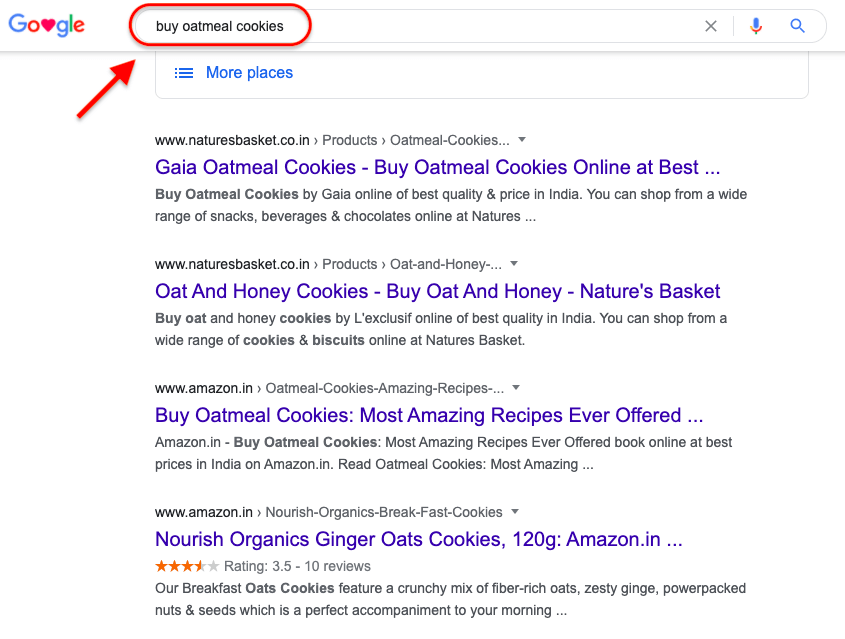
For this reason, if you want to rank your pages on page 1 of Google in 2021, you need to understand the concept of search intent and create content that matches the user's intent.
There are four types of search intent:
- Informational: The search has an informational intent where the user is looking for specific information. This can be a simple search such as "what's the weather like today?", where the results are short and clear, or it can be a search for "the best SEO strategy", where the content of the search will already be broader and more detailed.
- Navigational: In this case, the searcher is looking for a specific website or application. Common examples of navigational searches are "log in to Facebook", "SEMrush" and "Amazon".
- Commercial: The purpose of the search is commercial, where the user is looking for a specific product but has not yet made a final decision. For example, searches such as "best SEO tools" and "best DSLR cameras" are commercial searches.
- Transactional: the intention here is to buy. The searcher has already made a decision to buy a particular product or tool. Examples are searches such as 'buy Nikon d500', 'buy Macbook Air' and 'buy groceries online'.
The best SEO practice is to always keep the search intent in mind when creating your website content.
For example, if you want to rank for the keywords "best DSLR cameras", you need to understand that the purpose of the search is commercial, not transactional. The consumer is still undecided about which DSLR brand to choose.
There is no point in optimizing your DSLR landing page for these specific keywords. Google understands what consumers want, when the search query is "best DSLR cameras", they look for options. People are looking for a blog post or a video with the best DSLR cameras, their reviews and testimonials, not product or e-commerce pages.
Important: create content that is relevant to your target audience's search intent.
2. Write a quality meta tag and meta description
Your page title and meta description are the two most important meta tags on your page.
Title tags
Title tags are short headings that tell you what the page is about, they are visible in search results and are very critical for SEO.
According to Google:
"Title tags are essential for giving users a quick insight into the content of a result and why it's relevant to their query. This is often the key information used to decide which result to click on, which is why it's important to use high quality page titles on your web pages. "
Search engines such as Google typically display the first 50-60 characters of a title. It is therefore important not to exceed 60 characters in order to see the full title.
Here are some other best practices to consider when creating title tags:
- Include your target keywords.
- Write a title that is relevant to the search intent.
- Avoid creating duplicate title tags.
- Don't use too many keywords
- Keep the title descriptive but concise.
Meta descriptions
The second most important meta tag on a page is the meta description. The meta description is a short summary of the pages displayed under the title tag in search results.

Meta descriptions do not directly affect search engine rankings, but they can affect click-through rates.
Google explains it best:
"The meta description tag should generally inform and engage users with short, relevant summaries of what a particular page is about. They are like a step that convinces the user that the page is exactly what they are looking for."
Google usually shortens meta descriptions to 155-160 characters, so make sure you provide an accurate summary of your content, keeping it under 160 characters.
Here are some best practices to follow when writing meta descriptions:
- Write unique meta descriptions for each page.
- Include your target keywords.
- Be relevant to the search intent.
- Provide an accurate summary.
3. Optimize images
Images play an important role in improving the experience of your website visitors. Chances are you spend a lot of time choosing the right images to enhance your blog posts, product pages and other important pages on your website.
But do you spend the same amount of time optimizing images for your website? When used properly, images can contribute to your website's overall SEO and increase organic traffic. Here are four things you can do to optimize your website images.
Choose the best file format
Site speed is an important ranking signal, and images often have the biggest impact on overall page size. Therefore, to improve the overall performance and loading speed of your website, you need to optimize your images. The first step in optimizing images is choosing the best file format, so let's compare JPEG , PNG and WebP. The most common image formats used on the web are JPEG and PNG. Both of these formats use different compression techniques, so the file sizes between the two can vary considerably.

Looking at the differences in file sizes above, it would be easy to declare JPEG the clear winner. However, it would be a mistake to use JPEG as the actual image format for your website. While JPEGs are great for photographs (as shown in the image above), for images containing text, line drawings and the like, PNG is the best format. This illustration from Digital Inspiration proves the point.

WebP is another option for image optimization, it is a modern image format that provides superior and quality-neutral image compression. With WebP, image compression is possible by 25-36%.
Learn more about how to use WebP in this Google guide.
Compress images
The larger the size of your image file, the longer it takes to load a web page, so it's essential to compress your images before uploading them to your website.
Fortunately, there are a number of free tools that can help you reduce the size of your images.
- TinyPNG: TinyPNG uses clever compression techniques to reduce the file size of PNG and JPEG files.
- ImageOptim: If you are a Mac user, you can download and use this free tool for all your image compression needs.
- ImageOption is a tool recommended by Google. It is definitely the best JPEG compression tool. If you want to compress PNGs, TinyPNG is a better choice.
- ShortPixel: if your website is built on WordPress, you can install this plugin to compress images. The free ShortPixel plan allows you to compress 100 images per month.
Provide Alt text for images
Despite Google's progress in improving images, it is still necessary to replace the text accompanying images. Adding alternative text to images improves web accessibility and helps browsers better understand your website images.
Here's what Google says about writing alternative text:
"When choosing alternative text, focus on useful, information-rich text that makes good use of keywords and is relevant to the context of the page content.
Avoid overstuffing Alt attributes with keywords, which leads to a negative user experience and can result in your site being seen as spam."
When writing alternative image text, keep descriptions concise and avoid targeted keywords.
Lazy Load function for images
Lazy Load is a method that delays the loading of non-critical resources (images, videos, etc.) during page loading. Images and videos are loaded only when users need them.
Here's how Google explains the link between Lazy Load and website performance: "By using Lazy Load for images and videos, we reduce the initial page load time, the initial page weight, and the use of system resources, all of which have a positive impact on performance".
Learn more about Lazy Load in the Google Resource Guide.
To lazily upload your images and videos to WordPress, you can use the free a3 Lazy Load plugin.
- Optimize your website speed
If your website has a slow loading speed, it can lead to a negative experience for your users, which can result in a drop in your website's rankings.
There are several free tools that can help you check your page speed, one of which is Google's own PageSpeed Insights.
For this task, I recommend using GTMetrix. This free tool provides insights into your page speed and makes recommendations on actions you can take to improve your load times.
You can also use SEMrush to audit your site and resolve any performance issues. Here's how:
- Log in to your SEMrush dashboard and go to Projects > Add New Project > Enter your domain.
- Enter all your information here and click "Start Site Audit."
- Within seconds, SEMrush will generate an audit report outlining all the on-site errors you need to correct to improve your overall SEO health.
- From the audit report, go to "Site Performance" and click the "View details" button .
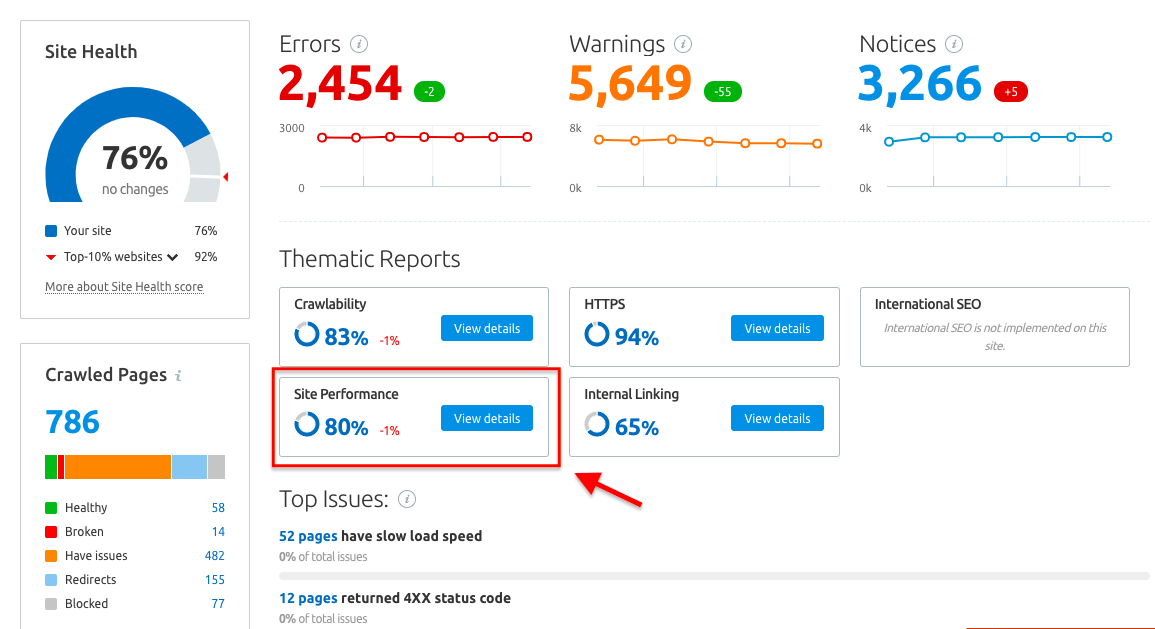
You can now view any performance issues on your website that are preventing it from loading pages faster, and what action you should take to resolve the issues.

A quick and easy way to improve your page speed would be to compress your images.
In addition to image compression, here are some other things you can do to make your pages load faster:
- Enable browser caching.
- Delete unnecessary plug-ins.
- Reduce server response times.
- Reduce the number of redirects.
- Reduce CSS and JavaScript files.
5. Use internal linking
Internal links are important because they create a hierarchy of information on your website and help Google better understand the content of your page. Internal links can significantly improve your ranking when used correctly.
In this case, NinjaOutreach increased its organic traffic by 40% by optimizing internal links. The best SEO practice that works is to add internal links from the highest-ranking pages on your website to pages that need improvement.
You can also use SEMrush to identify and correct internal linking errors on your website. The Internal Linking Report SEMrush website audit tools can be very useful in identifying problems with the internal linking structure of your website.
- Audit your website in SEMrush to generate an SEO audit report.
- Go to "Internal Linking" and click on the "View details" button.

You can now review and resolve any internal linking issues on your website.

- Improve the user experience on your website
Google keeps a close eye on how users engage with your content. User experience is one of the key factors in improving your search rankings.
Page speed plays a vital role in improving the visitor experience on your website.
Here are some other tips to ensure a good user experience when visiting your website:
- Use heading tags: Proper use of subheadings (H1, H2, H3) helps Google better understand your content and make your text more accessible to readers.
- Make your content visually appealing: Several studies show that images help people understand your content better. Use relevant images, videos and screenshots to illustrate your points.
- Avoid using intrusive pop-ups: pop-ups are not only bad for SEO but also annoy visitors. Since 2017, Google has been penalizing websites that use intrusive pop-ups. So use pop-ups sparingly. If you must use them to grow your subscriber base, use exit pop-ups or show them to users who have spent at least 5 minutes on your website.
- Use white space: white space is a key aspect of good design. According to Crazy Egg, spacing between paragraphs and left and right margins increases user engagement by 20%. So consider adding white space to make your content look streamlined and draw the user's attention.
7. Include keywords in your URL
URL structure is an often overlooked aspect of SEO. A good URL structure gives users and search engines an idea of what the destination page is.
Google explains:
"The URL structure of a website should be as simple as possible. Consider organizing your content so that URLs are created in a logical and human-readable way (readable, understandable words where possible, rather than long ID numbers). "
With that in mind, here's how you can create a well-structured URL:
- Use short URLs: a study by Backlinko showed that short URLs tend to outperform long URLs in search engines.
- Use keyword-rich URLs: Always include targeted keywords in URLs to increase the chances of ranking better in search results.
- Remove unnecessary words: To make your URL look clean and concise, consider removing unnecessary words.
8.Pay attention to high authority backlinks
Despite several changes to Google's search algorithm and ranking system, Google still considers backlinks to be a key ranking factor. Google recognizes backlinks as a sign of trust.
If your web pages have a high number of backlinks, it increases the likelihood of ranking higher in the search results. It is therefore important to focus on building backlinks to your website.
Also, not all backlinks create the same value. Some backlinks can boost your ranking for specific search queries, while others can have a negative impact on your rankings. You should therefore give preference to authoritative backlinks over low authority backlinks.
You should concentrate on high quality backlinks that can improve your chances of ranking higher for your target keywords. One of the most effective ways to get authoritative links is to replicate your competitors' external link building strategies.
You can use the SEMrush Backlink Gap Tool to explore untapped link building opportunities and analyze competitors' backlink profiles.
To get started:
- Go to Gap Analysis -> Backlink Gap.
- Enter your domain as well as the domains of your top four competitors and click on "Find prospects".
The Backlink Gap tool will display a graph and a table showing a comparison of the backlink profiles of competitor domains. The graph provides a quick glance at your competitors' recent link building activity.
To set up link building opportunities on your website, select a domain from the drop-down menu above the table.
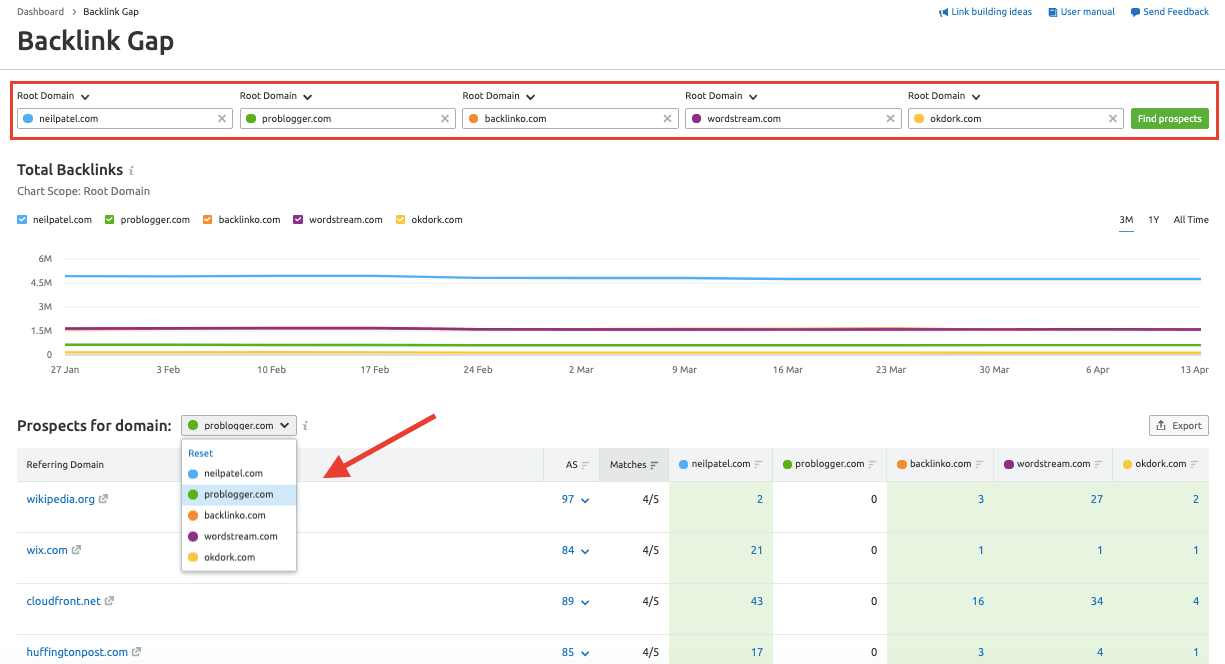
This list will contain sites that redirect to your competitors' domains. Armed with this knowledge, you can start a campaign to find the most authoritative competitor backlinks.
9. Host high volumes of quality content
Long-form content ranks better on Google. This is supported by several studies, including a recent SEMrush study on the top performing articles.
The main finding of the study showed that long-form articles (posts with more than 3000 words) receive 3x more traffic, 4x more shares and 3.5x more backlinks than medium-length articles (901-1200 words).
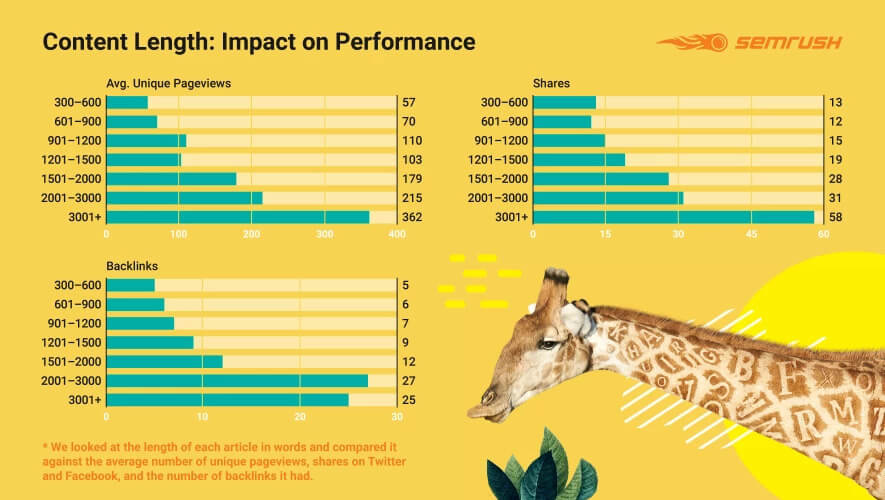
In short, content length and search performance are closely linked.
For this reason, you should aim to publish 1-2 high quality, long-form articles that contain useful and relevant information for users. Google wants you to focus on the user's needs and not on SEO. However, we all know that SEO is also important.
When creating high-volume content for your blog, focus on keywords that strike a good balance between the number of searches and the complexity of the keyword.
Long-tail keywords tend to have low search volume, but in some cases they can help you reach the customers you need. If the search volume is simply too low, look for medium-length keywords with low to medium keyword complexity.
You can use SEMrush to set a keyword complexity score for all the keywords you want to use in your content.
- Enter your keyword(s) in the SEMrush search bar and click on the "Search" button.
- The Keyword Overview report will provide you with basic data such as total search volume, keyword complexity, etc.

You can scroll down to see keyword variations, questions and related keywords. Click on the "View all" button under each of these sections to see the different variations of the original keyword(s) along with useful keyword metrics.

Using this data, you can determine which keywords to use when creating long-form content.
Conclusions on SEO best practices
The SEO best practices described above are a great starting point for achieving higher search rankings. In addition, competition for the coveted first page of Google is fierce, regardless of the niche in which you operate. Once you've adopted these practices, make sure you're quick enough to keep up with the latest SEO trends. It's important to keep an eye on the latest techniques and to keep up with them, and to keep improving in order to survive in this battle for the first position on the page.
Source: SemRush Blog


